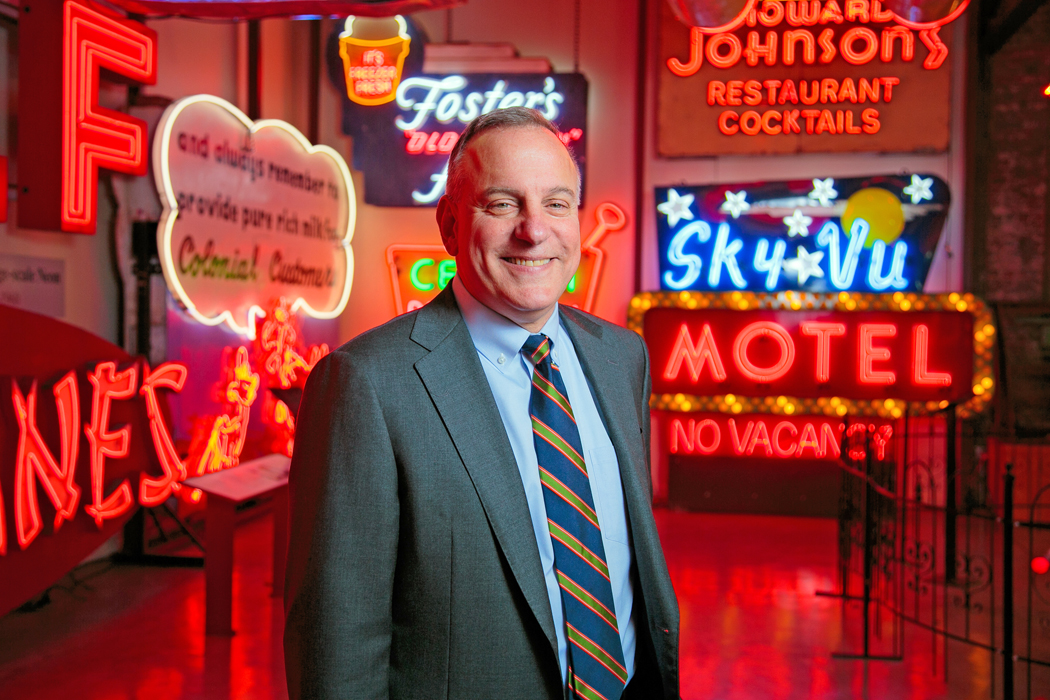Brad Huberman was named executive director of the American Sign Museum (Cincinnati) earlier this year, replacing Tod Swormstedt, who transitioned to founder/curator. Huberman was previously the museum’s managing director.
Did you have any experience in the signage and graphics industry prior to joining the American Sign Museum in 2010?
I did not. But I was a collector.
You collected signs?
I did. When Tod interviewed me, I sent him a picture of my living room. I had some giant neon signs. I said, ‘You really shouldn’t need to ask me anything else.’ But, no sign experience. I’m more like the typical visitor to the museum. I like signs and I collect them.
Why did you make the turn into the sign industry?
I love the project. The two things I excel at are fixing something that’s broken and creating something that hasn’t been. The museum, moving from the original Essex place to this building, was a completely new opportunity, and I just loved it. It was a huge opportunity to bring the Sign Museum into prominence in Cincinnati and the rest of the country.
What prompted the decision to move into this new role, one that had only been held by Tod?
Since the museum is expanding, my taking over the day-to-day operations 100% allows Tod to focus mostly on the design, the fundraising and expansion of the museum, and the collection. He really gets to work on making sure that we get the next phase completed. And I support him in that role. It was a natural progression.
The American Sign Museum has become much more than a collection of vintage signs – it’s now a full-fledged events center. Was the idea for the museum to be more than a collection of vintage signs always there, or did it happen spontaneously?
I would think it’s somewhat intentional. The events end of the museum is the driver for everything else. The events provide us with 40% of our operating income. Having events was the driver for being able to create more educational programs, more of everything. Being able to expand the museum will enable us to become a better museum and be able to better represent the sign industry. With a larger space, we’ll be able to offer more of a menu of events. The expansion of events will allow for more sign-related programming.
Advertisement
Earlier this year, the museum announced plans to expand into 20,000 sq. ft. of its existing, but undeveloped quarters. Among the plans are a commercial signshop, a maker space and a library.
We consider Neonworks [the functioning neon shop housed within the museum] to be our first maker space. We’d like to have a signpainter shop. We’d possibly like to have a metal shop to fabricate sign cabinets. We definitely want to have more maker spaces where people can watch signs being made and hand crafted. The library has a lot of photos and books that people need to be able to access for research projects.
What else would you like to see the museum accomplish in the future?
The expansion is really the beginning. One of the things I’d like the museum to be able to do with the expansion is to have changing exhibits. That’s one thing we are limited to now; most of the collection, the Signs on Main Street space, is static. We need to have a space where we can have changing exhibits, a reason for local people or even non-local people to come back a second and third time. Also, I’d like to see our education programs, especially kindergarten through eighth grade, expanded. And that will happen when we have more dedicated space.
What role do you see the museum playing for the sign industry at large?
We get a lot of positive feedback from the sign industry. We feel that one of the things that we’re doing to help the sign industry is that the public is understanding that there is an industry, that it’s a craft and a business. That there’s a huge value to good signage and to signage in general. I don’t know that we’re educating the sign industry; we’re telling a story. This is a legacy to the industry. Currently we represent the past and the present a little bit. At some point, we have to represent the future maybe as we move forward.
The interview has been edited for length and clarity.


 Tip Sheet4 days ago
Tip Sheet4 days ago
 Business Management2 weeks ago
Business Management2 weeks ago
 Women in Signs2 weeks ago
Women in Signs2 weeks ago
 Real Deal5 days ago
Real Deal5 days ago
 Benchmarks1 day ago
Benchmarks1 day ago
 Editor's Note1 week ago
Editor's Note1 week ago
 Line Time2 weeks ago
Line Time2 weeks ago
 Product Buying + Technology1 week ago
Product Buying + Technology1 week ago














